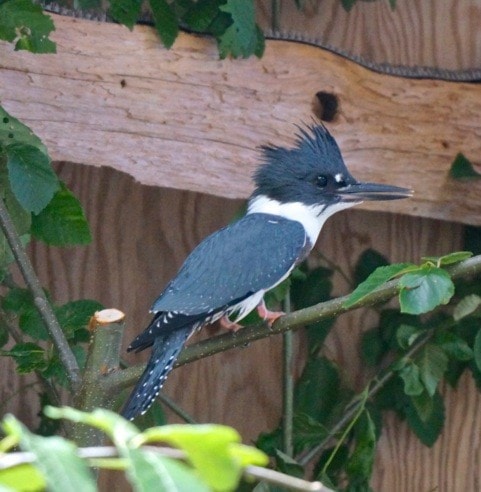It is quite easy to miss a solitary, motionless bird perched along a river bank, shoreline or lake as it sits waiting for an unsuspecting fish to pass by. But, a raucous rattling call will reveal an intriguing, beautiful and somewhat elusive bird, the belted kingfisher.
They are found across Canada and in the west from Alaska to Central America, with some birds being year-round residents. Locally a good place to watch for kingfishers is along the Puntledge and Campbell rivers or along the coastline from Courtenay to Union Bay, I have also seen them perched on the rocks at Comox Harbour.
A stunning medium-sized, stocky bird, the female kingfisher has a blue/grey body, and dark grey head with a shaggy crest on top. Females, unlike most species, are more brightly coloured than the males; the male is darker blue. Both sexes have a white collar around their necks and the females have beautiful chestnut rufous band below this collar extending down the flanks; both also have white under parts.
Kingfisher tails are quite short and are spotted with white and some white banding on the tail ends. There is usually no doubt when identifying these birds they have two unmistakable features. One is the long heavy dagger-like beak which they use to loosen dirt when excavating their nest and it is also used to pound fish against a perch before consuming the prey. The other feature is the two front toes which are fused together just below the nails these are used as shovels when they dig out their nest in sand or soil.
Usually you hear these birds long before you spot them when they are actively fishing, and their fishing skills are fascinating to watch. As their name suggests their food of choice is fish but some will also eat amphibians, small crustaceans, insects and small mammals. Salmon and trout fry are a special delicacy for these birds which are known to steal from fish hatcheries. They perch on trees, posts, rocks or other suitable 'watch points' close to the water, diving in headfirst when they spot prey. Before diving in they will often hover above the water, and once they enter the water they open their wings in order to keep the dive shallow. Their thick plumage is heavily oiled and extra layers of downy feathers help insulate them against the cold water.
It may surprise you to know that kingfishers, like many other birds, cast pellets consisting of fish scales, bones, pieces of shell, or other material they cannot digest. Kingfishers are one of a few land birds that actually excavate their nest site, tunnelling into suitable dirt banks usually located along rivers or lakes. Mated for life, both birds are involved in nest building that is truly a labour of love. They loosen the dirt with their beak and shovel it with their fused toes, which can take up to fourteen hours. The tunnel can be between 30 and 250 centimetres in length and usually is slanted uphill to protect the nest from high water, ending in a bare nest chamber. Between five and eight eggs are produced and the young are born blind and totally naked; as their feathers begin to emerge from the feather shafts they resemble pre-historic monsters.
Kingfishers are not frequent visitors to MARS but last week we received two kingfishers, one recent hatchling and another adult bird. The baby kingfishers resemble porcupines with their stiff emerging feathers — truly only a mother could love them! These are highly strung birds that become extremely stressed in captivity, refusing to eat. It is also very difficult to replicate their habitat and allow them to dive as they normally would in the wild. It is hoped that the young kingfisher will learn some skills from the adult bird and be returned to Comox Lake where it was found on shore, maybe as a result of a dog. Kingfisher populations seem to be stable and they are one of the few species that seem to benefit from some human development. They are making nests in dirt banks made from road construction and gravel pit excavations, but are still vulnerable to loss of safer natural nest sites along rivers and waterfronts where humans like to spend recreational time.
A big thank you to all those who have supported MARS at a few public events. We will be at most of the remaining public events this summer and still have some raffle tickets available; your support will help us continue to help wildlife. To report injured of orphaned wildlife please call 250-337-2021 to report injured wildlife before intervening with an injured creature or visit www.wingtips.org.
Sandy Fairfield is the educational co-ordinator for the Mountainaire Avian Rescue Society (MARS). The MARS column appears every second Thursday.
